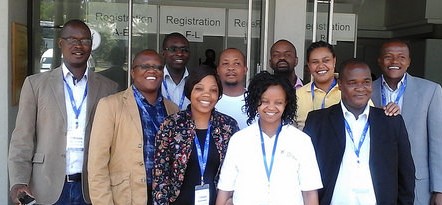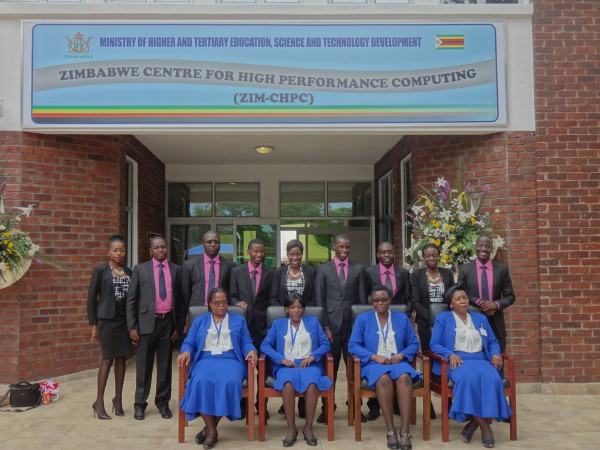South Africa’s Kruger National Park was the perfect setting for the conservation-themed, Ninth Annual Center for High Performance Computing’s (CHPC) National Meeting titled “Towards an Energy-Efficient HPC System.” Additional meetings were co-located Dec. 1-5, 2014, including the Southern African Development Community (SADC) HPC Forum, HPC Advisory Council, and the Industrial HPC Advisory Forum.
CHPC Director Happy Sithole opened the conference by thanking conference sponsors, especially its diamond sponsor, Intel, and welcoming 305 HPC enthusiasts from 19 countries and 12 research arenas, including SADC delegates, system administrators, researchers, computational scientists, and industry affiliates. Ninety-two South African students presented posters, or competed for a chance to represent South Africa in July at the HPC Advisory Council International Supercomputing Conference (HPCAC-ISC) Student Cluster Competition in Frankfurt, Germany.
Kruger is one of South Africa’s largest national parks, and home to 336 native trees, 49 fish, 34 amphibians, 114 reptiles, 507 birds, and more than 140 mammalian species that roam freely in a sanctuary the size of Slovenia (or New Jersey-U.S.). Summer had just begun and Kruger’s “Big Five” were active, including rhino, elephant, buffalo, lion, and leopard. The most dangerous animal in South Africa isn’t among the Big Five. Hippos are responsible for the most human deaths and are consequently killed by people who feel threatened, or poached for their tusks, fat and meat.
The Skukuza rest camp features an elegant airport with daily Airlink service from Johannesburg. Its Cattle Baron restaurant serves a Madagascar Peppercorn Steak that would impress the most discerning human carnivore. Additional amenities include a new conference center, air-conditioned bungalows, and paved roads where guests view wildlife from the safety of ranger-driven safari trucks.

Pre-conference workshops, tutorials, plenary talks by international experts, and breakaway sessions spoke to the very heart of HPC. The program was thoughtfully selected to explore energy-efficient HPC architectural concepts, strategies for software optimization, advances in middleware, international cyberinfrastructure (CI) policy, industry expectations, and a road map for pan-African human capital development (HCD). A conference help desk was available for attendees with questions about CHPC resources. Students engaged in collegial competition, and a less friendly, but highly entertaining, HPC Vendor Crossfire was chaired by Addison Snell (Intersect360 Research).

The intimacy of the conference venue was quite a change for those who attended SC14 one month prior with more than 10,000 attendees in New Orleans’ mile-long urban convention center.
“It was actually a refreshing change to have limited Internet access,” observed attendee and presenter Robert Sinkovits (San Diego Supercomputer Center-U.S.). “This encouraged everyone to close his or her laptop and focus on the conference. It was the first time I experienced a power outage while giving a presentation. I used the ten minutes of semi-darkness to answer questions and to discuss my research.”
“Overall, it was one of the best conference experiences I can remember—just the right size and with a great bunch of culturally-diverse attendees, fantastic poster sessions, top-notch plenary speakers and a phenomenal venue. What’s more, it was great to see African speakers focusing on locally-important research problems, such as detailed studies of southern ocean currents,” said Sinkovits.
SADC HPC Forum
Delegates from Botswana, Zimbabwe, Zambia, Lesotho, Tanzania, and South Africa attended the third annual SADC HPC Forum. On behalf of the SADC Secretariat, the two-day session was called to order by Senior Technical Adviser Anneline Morgan (SADC Science, Technology and Innovation, Social and Human Development and Special Programs), and presided over by SADC Forum Chair Willie Ganda (Zimbabwe) who will represent the forum at the June, 2015 SADC ministerial meeting in Zimbabwe. Sithole and Ms. Mmampei Chaba (Dept. of Science and Technology, South Africa) welcomed 30 SADC delegates and international advisers.
Morgan framed SADC’s mission and strategies toward a shared vision of peace, security, international trade, and HCD. Ganda expressed the importance of SADC’s continued progress toward a fully-functional, shared CI.
“Through education and research excellence, SADC member-states can uplift citizens from poverty and enable Africa to compete in global research and industrial theaters,” said Ganda. “SADC’s collective research will be a key enabler for success in a range of high-value industries.”

Dr. Sithole shared constructive feedback from the June 2014 SADC ministerial meeting. “The ministers expressed appreciation for our having established high-level objectives and timelines, and are pleased that we are as concerned with HCD and research as we are with the technology,” he said. “They would like us to spend our time together this week developing an implementation framework; we must determine how, when, and by whom each objective will be executed. With a well-defined plan, we will then be prepared to solicit industry partner and SADC ministerial support,” he added.
During this forum, SADC delegates presented national research priorities, progress made since last year and described what they will need to succeed in the future.
Infrastructure
The South African Department of Science and Technology’s Council for Scientific and Industrial Research (CSIR) first planted the seeds of a national CI in 2007 when CHPC was launched. Since then, Sithole has envisioned the build-out of a multinational high-performance regional network, a shared software stack, and digital trust fabric to provide the foundation for a productive and secure interfederated research and education CI for sub-Saharan Africa.
With the Square Kilometer Array (SKA) locating in the Karoo region of South Africa, and instrumentation planned in many SADC locations, there’s an emphasis on data-driven research. To advise on best practices relating to data-intensive research and multinational policy-making, Anwar Vahed (CSIR/Meraka Institute-SA) joined the SADC-HPC Forum discussions.
While some national HPC centers are further along and better funded than others, Sithole explained that all will benefit from the shared CI—especially where there are limited local resources. “While the Ranger installation was the catalyst for HPC engagement, it’s only the beginning. There’s an x86 system in Zimbabwe similar to Ranger, and more racks are promised by the University of Cambridge. Everything will be accessible, and shared,” said Sithole.
He also added that cloud-enabled, infrastructure-as-a-service is commercially available, and CyberSKA, a cloud-enabled portal for infrastructure located at CHPC, provides access to a variety of SKA-related test-bed systems. Advisers suggested that SADC researchers will benefit from U.S. and European-based innovation ecosystems and science gateways. “Not only are there resources earmarked for use by specific domains, they offer secure, data-transfer solutions to bridge technical and policy barriers between multinational collaborators,” shared Vahed.

Human Capital Development
SADC delegates are eager to learn the skills necessary to create a national point-of-presence for computational provisioning and workforce development. Adviser Dan Stanzione (Texas Advanced Computing Center, TACC-U.S.) expressed the importance of preparing multiple support communities, including systems builders, operators, trainers, and researchers. In addition to the training offered during the 2015 CHPC meeting, Sithole added that the student cluster competition is an excellent way to prepare young people to envision the possibility of pursuing high-tech careers. While it’s only sponsored by South Africa now, Sithole hopes it will be a SADC-wide competition in the future.
SKA contributed training resources to SADC HPC Forum institutions in South Africa, Mozambique, Botswana, Namibia, Mauritius, and Zambia, and non-SADC universities in Ghana and Kenya. Their training program requires 10 terabytes of local storage, which added to the Ranger rack implementation cost in some cases, according to CHPC’s Nick Thorne who is leading that effort.
In an effort to jump-start scientific and educational collaborations with SADC member nations, the U.S. National Science Foundation (NSF) is supporting local U.S. expenses for 16 visiting SADC scientists and system administrators so they can attend a Nov. 2015 training workshop at TACC prior to the SC15 conference. The first leg of their journey (16 African round-trip flights) is being donated by Airlink Airlines, and STEM-Trek hopes to find sponsors for the remaining 64 flights.
“NSF recognizes that HPC is a fundamental enabler of agricultural research and plant biology which are priorities for TACC and SADC, alike,” said Stanzione. “Through their investment, NSF hopes to foster future U.S./pan-African collaborations,” he added.
Throughout the HCD discussion, advisers volunteered knowledge of a variety of free or low-cost HPC training resources. The list is available on the STEM-Trek site.
Ranger Implementation
Eighty-four racks of TACC’s Ranger system were donated by the University of Texas at Austin-U.S. (UT). CHPC shipped one fourth of the racks to South Africa (SA) in late 2013 with the intention of distributing them among SA universities to create mid-level HPC services. Additional SADC regions received racks directly from TACC, namely Tanzania (16), and Botswana (4). CHPC augmented the SA racks with additional hardware that allows them to function as stand-alone clusters, and distributed them to the University of Fort Hare (Eastern Cape), University of KwaZulu Natal), University of Venda (Limpopo), and University of the Witwatersrand (Gauteng). Two racks will be hosted by the Zambia Research and Education Network group. During the meeting, Lesotho expressed an interest in hosting resources, too.
“It wasn’t as easy as we thought it would be to create many, small clusters from a large system,” said CHPC’s Thorne. “There were unforeseen costs and physical challenges, but it has been highly successful, nevertheless.”
“There has been surprising demand for upcycled systems,” he continued. “In Africa, hardware is more expensive, but energy and personnel are less costly than they are in the U.S. or Europe, so there’s a stronger case to keep systems in production longer.” Since UT donated Ranger, others have offered their decommissioned hardware, including Cambridge University.

Zimbabwe’s effort first began in 2011, and a recently- renovated building houses their new datacenter. Their X86-class system (similar to Ranger) will be shared with the SADC-CI, and they have plans to expand. Next to CHPC in South Africa, Zimbabwe’s center is the second brightest point-of-presence on the regional CI front. With redundant data and power, plus three 120 kw back-up generators, Zimbabwe’s datacenter will be able to support up to 36 teraflops of processing power.
To establish Zimbabwe’s HPC center, Ganda lobbied and appealed to e-government agencies and regional industries (mining and agriculture). He helped them understand how a local HPC center will impact economic, research and educational outcomes. A similar funding strategy (with cross-functional private and public support) has been effective in South Korea, according to SADC HPC Forum Adviser Cynthia McIntyre (Council on Competitiveness-U.S.).
 Tenth CHPC National Meeting,
Tenth CHPC National Meeting,
Port Elizabeth, South Africa, Nov. 30 to
Dec. 4, 2015
Sithole thanked conference sponsors Intel, Dell, Altair, HP, Huawei, Data Direct Networks, Seagate, Amazon Web Services, Mellanox, Eclipse Holdings, and Rectron. He hopes everyone will return next year for their tenth national meeting at the Boardwalk Hotel in beautiful Port Elizabeth, known as the “Friendly City.”
Watch for updates about the HPCAC-ISC Student Cluster Competition, SC15 TACC Workshop and the 2015 conference on the CHPC site.

About the Author
 Elizabeth Leake is the president and founder of STEM-Trek Nonprofit, a global, grassroots organization that supports scholarly travel for science, technology, engineering, and mathematics scholars from underrepresented groups and regions. Since 2011, she has worked as a communications consultant for a variety of education and research organizations, and served as correspondent for activities sponsored by the eXtreme Science and Engineering Discovery Environment (TeraGrid/XSEDE), the Partnerhip for Advanced Computing in Europe (DEISA/PRACE), the European Grid Infrastructure (EGEE/EGI), South African Center for High Performance Computing (CHPC), the Southern African Development Community (SADC), and Sustainable Horizons, Inc.
Elizabeth Leake is the president and founder of STEM-Trek Nonprofit, a global, grassroots organization that supports scholarly travel for science, technology, engineering, and mathematics scholars from underrepresented groups and regions. Since 2011, she has worked as a communications consultant for a variety of education and research organizations, and served as correspondent for activities sponsored by the eXtreme Science and Engineering Discovery Environment (TeraGrid/XSEDE), the Partnerhip for Advanced Computing in Europe (DEISA/PRACE), the European Grid Infrastructure (EGEE/EGI), South African Center for High Performance Computing (CHPC), the Southern African Development Community (SADC), and Sustainable Horizons, Inc.





























































